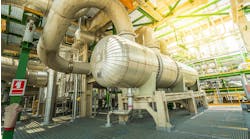Are your pressure vessels rated for both the upper operating pressure and full vacuum? An old rule-of-thumb says the incremental cost for a full vacuum rating on a pressure vessel is small to nonexistent once the pressure rating reaches 50 psig. However, don’t count on this — not every vessel that has a 50-psig rating can safely operate at full vacuum.
On one recent job, a new carbon-steel drum, 12 ft. long by 4 ft. in diameter, only would meet full vacuum conditions if the shell had a pressure rating of 116 psig. This required an increase in shell thickness to 10/32 in. from 7/32 in. Yes, it meant spending more money but we went ahead with the full vacuum rating anyway. The cost impact of a few pounds of carbon steel was low compared to that of vacuum protection systems.
In comparison, large vessels may justify not having a full vacuum rating. A recent check showed about a 20% savings for a 10 ft. diameter by 82 ft. tall vessel at 16-psig internal pressure rating compared to getting the vessel rated for full vacuum — for both carbon steel and Type 304 stainless steel. This savings was on the materials and labor on the vessel and foundations only — the percentage reduction in total installed cost was much lower.
However, because the vessel lacks a full vacuum rating, it must be protected by vacuum breakers or other systems. These also have costs. The most that the 20% savings on the vessel would pay for was connection to a nitrogen-based vacuum breaking system. So, you might as well buy the vessel for the full vacuum rating to avoid complex protection methods. Plus, full vacuum systems have many advantages. You don’t have to worry about vessel failure due to low pressures during unusual operations, startup, shutdown or plant upsets. Sucking in of vessels can occur, for instance, from allowing steam to condense when air-freeing vessels, rapid draining of shut-in vessels, pumping out during shutdowns, and losing heat input to towers.
Some jurisdictions require the capability to hydrotest the entire vessel in place, either when built or at specific intervals. In one case with a 380 ft.-tall tower, this translated to 164 psi of water static head during the hydrotest plus the minimum hydrotest pressure needed at the tower top. Here, however, reaching a full vacuum rating for the entire vessel required only a few stiffening rings (at the top) — making the incremental cost for the full vacuum rating close to zero. A similar situation may occur when wind and seismic loads set wall thickness.
Full vacuum allows for using a hogging ejector to air-free vessels during startup. This rapidly sucks the air out. Purging with nitrogen for a final oxygen sweep is quick and cheap. For larger vessels, this may save 24 hours or more.
Vacuum systems that pull down the pressure to below the bubble point of water also can speed startup. Many processes are sensitive to either the water or the upsets that rapid vaporization can cause during startup. Dropping the pressure and then letting ambient heat gain vaporize small water pockets can rapidly dry equipment. This can provide very effective drying while avoiding the use of solvent.
Vacuum protection systems using air, fuel gas, nitrogen or other inert gases can protect equipment. However, after the vacuum breaker system works, you must remove the gases from the system. Getting them out may turn a minor upset into a major production loss.
Finally, don’t underestimate the cost of safety management for vessels not rated to full vacuum. Every safety review will need to investigate how vacuum can be created and how to protect against it. The time cost alone of multiple such reviews on vessels often will exceed the savings from not having a full vacuum rating on smaller vessels.
Not every vessel is a candidate for the extra expense of buying a full vacuum rating design. Very large vessels and those made of expensive alloys often will justify the safety hardware and management systems required instead. However, for smaller equipment and once design pressures go high enough or when other criteria (hydrotesting, wind or seismic load) set vessel structural design, the simplicity of full vacuum design can’t be beaten. So, carefully think through vessel purchasing requirements and don’t hesitate to call for full vacuum design unless you have good technical reasons or clear and compelling economic reasons not to.



